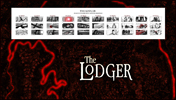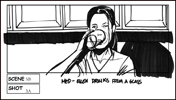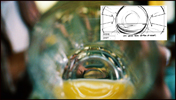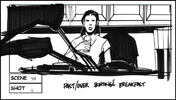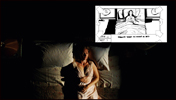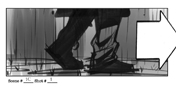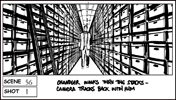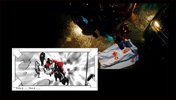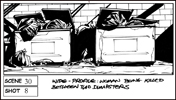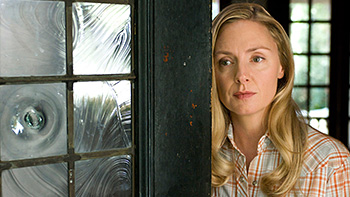
(written and directed by david ondaatje)
Contemporary adaptation of the novel, The Lodger, by Marie Belloc Lowndes set in Los Angeles starring Alfred Molina, Simon Baker and Hope Davis with two converging plot lines: The first involves an uneasy relationship between a psychologically unstable landlady and her enigmatic lodger; the second is about a troubled detective engaged in a cat-and-mouse game with the elusive killer. Re-adaptation of same book Hitchcock used for his 1927 thriller "The Lodger"
Sony Pictures Entertainment/Stage 6 Films
Theatrical Release: Samuel Goldwyn Films
Early dramatic events, main credit sequence and opening score…setting the story in motion during a dark rainy night in Los Angeles.
Time and sound are abstracted during Ellen’s (Hope Davis) interminable wait to bring her Lodger breakfast.
A frightening choreography of dialog, music and images convey Chandler’s (Alfred Molina) deep emotional reaction to his wife’s breakdown.
Time lapse photography and a split screen image of two women walking down Sunset Boulevard precede a fast inter-cutting montage of historical images from Street’s historical research and a gruesome attack.
Ellen (Hope Davis) and Malcolm (Simon Baker) are lost in a romantic and forbidden embrace as Ellen’s husband, Bunting (Donal Logue), draws dangerously closer.
The subjective and increasingly frenetic passage of time is conveyed visually and musically as Ellen (Hope Davis) cleans the guesthouse.
The attack of a woman by her assailant walking down a dark sidestreet is seen only through glimpses of their feet, necessitating that each viewer use his/her own imagination to visualize what is transpiring off screen. Set against the backdrop of a beautiful operatic voice singing Di Notte (Academy qualifying for Best Original Song).
Walking alone on Sunset Boulevard, Amanda (Rachael Leigh Cook) is stalked by a dark figure. Intercut with a montage of flashbacks of earlier attacks.
Cast and crew discuss the process of making the film (from behind the scenes/DVD).
Alfred Molina (Chandler), David Ondaatje (Writer-Director), David Armstrong (Cinematographer), and Michael Mailer (Producer) outline the visual style of the film and the challenge of capturing an array of unusual shots with a short shooting schedule (from behind the scenes/DVD).
Alfred Molina (Chandler) discusses his preparation for the role. Hope Davis (Ellen), Shane West (Street) and Rachael Leigh Cook (Amanda) also talk about working with the talented actor (from behind the scenes/DVD).
Simon Baker (Malcolm) explains the appeal of playing an unusual and detached character (from behind the scenes DVD).
Franco Giacomo-Carbone (Production Designer), David Armstrong (Cinematographer) and David Ondaatje (Writer-Director) discuss the film’s specific design parameters (from behind the scenes DVD).
Franco Giacomo-Carbone (Production Designer) discusses the film’s noir tone and how Hollywood is an important setting in the story. The crimes scenes in particular communicate a dichotomy between the appealing glow and neon of Sunset Boulevard and the dark ugly reality of its seedy back alleys (from behind the scenes DVD).
Flowing blood veins transition first into a map of the streets of Hollywood, and then into the abstracted view from the inside of a car driving in the rain…all foreshadowing the darkness, danger and abstraction of the story to come (from behind the scenes DVD).
The Director (David Ondaatje) reveals the film’s hidden references to specific shots from various Hitchcock films including: Blackmail, Spellbound, Vertigo, The Man Who Knew Too Much, The Lady Vanishes, Psycho and The Lodger (from behind the scenes DVD).
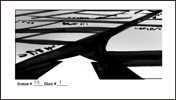

Jonathan Gesinski’s storyboards were used to pre-visualize the opening montage long before we started filming: pushing in on a map of West Hollywood, windshield wipers flapping against a window on a rainy night, POV driving down Sunset Boulevard, macro shots of a pen writing in red ink, close-up of a woman’s feet walking in the rain intercut with a close up of a man’s feet following her, pulling back from an extreme close up of a flashing red siren, arriving at the crime scene, pushing in on the covered body, Chandler’s (Alfred Molina) horrified reaction, and the crane shot rising high above the crime scene dissolving to a tracking shot along a quiet street toward the Bunting house the following morning.

IMDb
The Lodger, Sony Pictures Entertainment, Stage 6 Films.
Starring Alfred Molina, Simon Baker, Hope Davis, Shane West, Donal Logue, Philip Baker Hall.
Produced by Michael Mailer, David Ondaatje
Written and Directed by David Ondaatje

Apple.com Theatrical Trailer
Genre: Drama
Director: David Ondaatje
Cast: Simon Baker, Alfred Molina, Hope Davis, Shane West, Rachael Leigh Cook














































